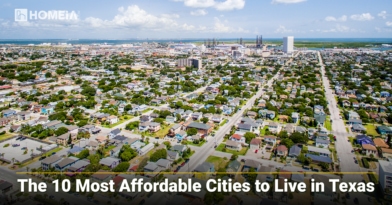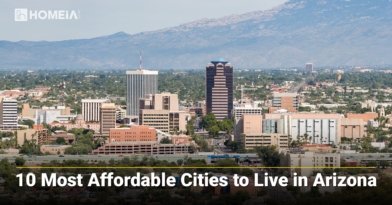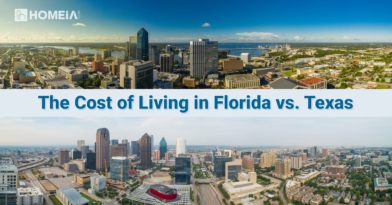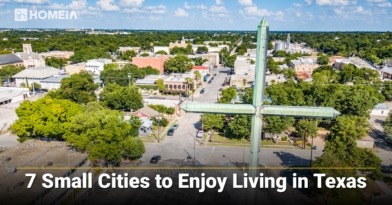11 Key Factors to Know About Living in New Mexico
- Author:by The HOMEiA Team
- Category: City Living Guide
Is New Mexico right for you? Here is a comprehensive guide to life in the Southwest. Located in the southwestern part of the United States, and nestled between Arizona and Texas, New Mexico has a blend of history, culture and natural landscapes that have earned it the nickname “The Land of Enchantment.”
Whether you’re considering relocating to New Mexico, investing there or simply visiting, this guide will provide an in-depth look into all that New Mexico offers. As we explore New Mexico’s housing market, job opportunities, cultural events and more, you will be able to make an informed decision about whether New Mexico is right for you!
Table of Contents:
- I. Housing: How Property Prices in New Mexico Compared to the Nation’s
- II. Job Opportunities: Finding Job Opportunities in New Mexico
- III. Education: Understanding New Mexico’s Growing Commitment to Education
- V. Healthcare: A Guide to New Mexico’s Medical Services
- VI. Transportation: Navigating New Mexico’s Transit Options
- VII. Nature & Climate: Discovering New Mexico’s Weather
- VIII. Seasonal Activities: Exploring New Mexico Year-Round
- IX. Local Cuisine: Savoring New Mexico — A Guide to Traditional Foods
- X. Historical Sites: Exploring New Mexico’s Rich Past
- XI. Cultural Insights: Exploring New Mexico’s Festive Spirit
- So, Is New Mexico Right for You?
I. Housing: How Property Prices in New Mexico Compared to the Nation’s
With a diverse offering of properties — from adobe homes in Santa Fe to modern apartments in Albuquerque — New Mexico offers options for every potential homeowner. Overall, comparing housing prices with the national average, property prices in New Mexico tend to be more affordable, making it an attractive option for both first-time buyers and real estate investors. Of course, factors such as location, property size and amenities play a crucial role in determining the price.
1. Growing Cities
The urban landscape of New Mexico is dynamic, with several cities experiencing a surge in housing demand due to various socio-economic factors.
- Santa Fe: The state capital and a cultural hub, Santa Fe has seen a steady increase in demand for housing, especially in the downtown area and surrounding historic districts. The city’s art scene, historic landmarks and cultural festivals make it a magnet for both tourists and new residents.
- Albuquerque: The largest city in New Mexico, Albuquerque has been experiencing growth in its housing market, especially in areas close to the University of New Mexico and the downtown district. The city’s tech and research sectors, driven by institutions like Sandia National Laboratories, have attracted professionals and boosted housing demand.
- Las Cruces: Located close to the border, Las Cruces has seen growth due to its university, New Mexico State University, and its proximity to El Paso, Texas. The city’s affordability compared to other southwestern cities has made it an attractive option for retirees and young professionals.
- Rio Rancho: A suburb of Albuquerque, Rio Rancho has been expanding rapidly. Its newer infrastructure and housing developments cater to families and individuals looking for modern amenities.
- Taos: Known for its ski resorts and art scene, Taos has become a hotspot for vacationers and those looking for a blend of outdoor activities and cultural experiences.
Recommended for you
2. Cities and Areas on the Decline
While some cities in New Mexico are thriving, others face challenges that have led to a slowdown in their housing markets.
- Rural southeastern New Mexico: Even though the oil and gas industry has brought economic growth to this region, housing demand tends to be cyclical and uncertain.
- Smaller towns: Towns like Tucumcari, once bustling due to Route 66, have seen a decline over the years as interstates and changing travel patterns have affected local economies.
- Deming and Lordsburg: Located in the southwestern part of the state, these towns have faced challenges related to economic development, which might impact housing demand.
Conclusion
Throughout the state, many major cities are experiencing growth, driven by the state’s natural and cultural attractions, educational institutions and economic developments. Overall, New Mexico’s housing market offers opportunities for homeowners and investors alike.
The 10 Cheapest Places to Live in Texas
They say everything is bigger in Texas, and for good reason. From some of America’s largest and active metropolitan cities to the host of recreational activities for people of all ages across the state to the many bigger-than-life personalities who call Texas home, Texas has plenty to offer for everyone. here’s the list of 10 lowest cost of living places…
II. Job Opportunities: Finding Job Opportunities in New Mexico
New Mexico’s employment sectors are shaped by its unique geographical and cultural attributes. With a mix of traditional industries and emerging sectors, the state offers a wide range of job opportunities for its residents.
1. Traditional Employment Sectors
New Mexico’s historical reliance on certain industries has cemented their role as major employment providers in the state.
- Agriculture: With a focus on crops like chiles, pecans and hay, agriculture has long been a staple in New Mexico’s economy.
- Mining: The state is rich in mineral resources, so mining, especially for potash, copper and gold, has been a significant sector.
- Oil and gas: Particularly in the southeastern region, the oil and gas industry has been a major employer and contributor to the state’s economy.
2. Emerging Opportunities
As the global economy evolves, New Mexico is adapting by fostering growth in new sectors.
- Renewable energy: With abundant sunshine and wind, the state is capitalizing on solar and wind energy projects.
- Aerospace: With facilities like Spaceport America, New Mexico is positioning itself as a key player in the aerospace and space tourism sectors.
- Digital media: Cities like Albuquerque are becoming hubs for digital media, animation and film production, offering a range of opportunities for creative professionals.
Conclusion
New Mexico’s job market reflects its adaptability and diversity. While it continues to support and grow its traditional sectors, the state is also embracing new industries, ensuring a dynamic and robust employment landscape for its residents.
The 10 Most Affordable Places to Live in Arizona
Arizona is world-renowned for its dramatic beauty, a combination of rugged mountains and vast desert landscapes. The sixth-largest state by area and the 14th largest in terms of population, Arizona is indeed beautiful–but it’s much, much more than that…
III. Education: Understanding New Mexico’s Growing Commitment to Education
With a range of institutions, from renowned universities and community colleges to innovative K-12 and vocational programs, the state offers quality education for its residents.
1. Trends in K-12 Education
K-12 education in New Mexico has seen several trends aimed at enhancing student experience and outcomes.
- Personalized learning: Schools are increasingly focusing on tailoring education to individual student needs, ensuring a more customized learning experience.
- STEM integration: There’s a growing emphasis on integrating science, technology, engineering and mathematics (STEM) into the curriculum to prepare students for future careers.
- Bilingual education: Reflecting the state’s diverse linguistic landscape, bilingual education programs are gaining prominence.
2. Trends in Vocational and Technical Training
Vocational training in New Mexico is adapting to the changing job landscape.
- Industry partnerships: Vocational programs are collaborating with industries to ensure curriculum relevance.
- Short-term certification programs: There’s a rise in short-term courses that offer certifications in specific skills, catering to immediate industry needs.
- Hands-on training: Emphasis on practical training ensures students are job-ready upon course completion.
3. Trends in Higher Education
Higher education in New Mexico is evolving to meet the demands of the modern world.
- Online learning: Many institutions are expanding their online course offerings, providing flexibility to students.
- Research opportunities: Universities are emphasizing research, fostering innovation and providing students with hands-on experience in their fields of study.
- Community engagement: Institutions are focusing on community-based learning, allowing students to engage with local communities and address real-world challenges.
Recommended for you
IV. Top Growing Higher Education Institutions in New Mexico
This list of the top growing institutions in higher education reflects New Mexico’s commitment to higher education, ensuring that students have access to quality education that aligns with modern trends and industry demands.
- The University of New Mexico (UNM): Located in Albuquerque, UNM has seen consistent growth in its research programs and has expanded its online course offerings to cater to a broader student base.
- New Mexico State University (NMSU): Based in Las Cruces, NMSU has been proactive in establishing partnerships with industries and increasing its focus on STEM programs, leading to a rise in enrollment and research opportunities.
- New Mexico Institute of Mining and Technology (New Mexico Tech): Renowned for its engineering and science programs, New Mexico Tech in Socorro has witnessed growth in both its undergraduate and postgraduate programs, driven by its strong emphasis on research and industry collaboration.
- Eastern New Mexico University (ENMU): Located in Portales, ENMU has expanded its academic offerings and has seen a steady increase in enrollment, especially in its online programs.
- Central New Mexico Community College (CNM): Based in Albuquerque, CNM, while primarily a community college, has seen growth due to its diverse range of vocational and technical programs tailored to meet industry needs.
Conclusion
New Mexico’s educational landscape is dynamic, reflecting the state’s commitment to academic excellence and adaptability. By recognizing and adapting to modern trends, the state ensures its students are well-prepared for the challenges and opportunities of the future.
Cost-Conscious Living in Utah: A Guide to the State’s Cheapest Cities
Each city holds unique surprises and perks for residents looking to make a savvy, budget-conscious move. So, let’s dive into these budget-friendly gems and see why they’re considered the best-kept secrets of Utah!…
V. Healthcare: A Guide to New Mexico’s Medical Services
New Mexico prioritizes the health and well-being of its residents. The state offers a mix of medical facilities, from general hospitals to specialized clinics, ensuring comprehensive healthcare services.
1. Top Hospitals and Medical Centers
Several hospitals in New Mexico provide a wide range of medical services.
- University of New Mexico Hospital, Albuquerque: This hospital is known for its advanced facilities and a team of experienced medical professionals.
- Christus St. Vincent Regional Medical Center, Santa Fe: Equipped with modern amenities, this facility offers diverse medical services.
2. Insurance and Healthcare Accessibility
New Mexico ensures that healthcare services are within reach for all residents.
- beWellnm: The state’s official health insurance exchange, beWellnm allows residents to find and purchase suitable health insurance plans.
- State initiatives: New Mexico has established programs designed to assist uninsured and underinsured residents, ensuring they receive necessary medical care.
Conclusion
New Mexico’s healthcare infrastructure is designed to cater to the diverse medical needs of its residents. From top-tier hospitals to specialized clinics and accessible insurance options, the state ensures quality and comprehensive medical care.
The Cost of Living in Florida vs. Texas
Texas and Florida are vast and have hundreds of communities to choose from. But what are the pros and cons of living in each state? Come with HOMEiA as we explore 7 crucial factors that reveal the true costs of choosing Florida or Texas as your new home…
New Mexico offers a range of transportation options for efficient travel across its varied landscapes. Whether you’re driving along scenic routes or using public transit in bustling cities, the state’s infrastructure supports seamless commutes.
1. Major Highways and Roads
New Mexico’s road network facilitates both short-distance and long-distance travel.
- Interstate 40 (I-40): This major east-west interstate highway runs across the state, including a stretch that follows the historic Route 66.
- Interstate 25 (I-25): This significant north-south route connects key cities like Las Cruces, Albuquerque and Santa Fe.
2. Urban Public Transportation
Public transit in New Mexico’s urban areas makes it possible to get from place to place without a car.
- ABQ RIDE: Albuquerque’s public transit system offers bus services throughout the city.
- Santa Fe Trails: Santa Fe’s bus system connects key areas within the city.
- New Mexico Rail Runner Express: This commuter train connects Albuquerque to Santa Fe and other smaller towns.
3. Air Travel and Airports
Air connectivity in New Mexico caters to both domestic and international travelers.
- Albuquerque International Sunport: The state’s largest airport offers flights to various domestic and select international destinations.
- Santa Fe Regional Airport: Serving Santa Fe and its surrounding areas, this airport offers flights primarily to major U.S. cities.
Conclusion
New Mexico’s transportation infrastructure is designed to cater to the diverse needs of its residents and visitors. From well-maintained roads to efficient public transit and air travel options, the state ensures that traveling within and beyond its borders is convenient and efficient.
7 Key Factors To Know About Living in Denver, Colorado
The Denver area is growing in population much faster than most of the country, increasing by almost 20% from 2010 to 2018. It’s no wonder; it rates as the second-best place to live in the United States, according to U.S. News & World Report (2019). Here’re 7 key factors you should know Before living in Denver Colorado…
VII. Nature & Climate: Discovering New Mexico’s Weather
New Mexico’s climate is as varied as its topography. From arid deserts to high mountain ranges, the state’s landscapes influence its weather patterns. As a result, the state experiences a mix of arid and continental climates, leading to hot summers and cold winters.
1. Seasonal Overview
New Mexico experiences all four seasons. While summers can be intensely hot in southern regions, winters introduce cooler temperatures, especially in the mountains, where snowfall is common.
- Spring: As winter snow melts away, spring in New Mexico is marked by blooming wildflowers, especially in the northern and mountainous regions. Temperatures begin to rise, but nights can still be cool.
- Summer: The state heats up all around, with southern locations like Roswell experiencing extreme heat. However, monsoon rains in July and August can bring relief, especially in the afternoons.
- Fall: Fall is picturesque, especially in the northern parts of the state where the cooler temperatures welcome changes in the foliage. The falling temperatures make fall the perfect season for outdoor activities.
- Winter: While the southern regions have milder winters, the northern and mountainous areas see significant snowfall, making them popular destinations for winter sports
2. Warmest Regions
New Mexico’s southern and southwestern regions are characterized by their notably warm temperatures, especially during the peak summer months.
- Roswell and Carlsbad: Located in the southeastern part of the state, these areas are known for their hot desert climate, especially during the summer months.
- Deming and Lordsburg: Situated in the southwest, these towns experience high temperatures, especially in the peak of summer.
3. Coldest Regions
The northern parts of New Mexico, particularly the mountainous areas, are known for their chilly winters, with significant snowfall and cooler temperatures.
- Taos and Angel Fire: Located in the Sangre de Cristo Mountains, these areas witness cold winters with significant snowfall, inviting winter adventure-seekers from around the world.
- Ruidoso: Nestled in the Sierra Blanca mountain range, Ruidoso experiences cooler temperatures and significant snowfall, making it another popular destination for winter sports.
4. Most Moderate Regions
While New Mexico boasts extremes in both warmth and cold, certain areas offer a more balanced climate, making them ideal for those seeking milder weather year-round.
- Santa Fe: At a higher elevation than cities like Albuquerque, Santa Fe has milder summers and moderate winters, making it an ideal four-season location.
- Silver City: Located in the foothills of the Pinos Altos Range, Silver City has a relatively moderate climate with milder summers and temperate winters.
Conclusion
New Mexico’s diverse topography results in a range of climate conditions. For newcomers, understanding the state’s weather is essential. Whether it’s preparing for the summer heat or the winter chill, being equipped for the season ensures a comfortable stay.
10 Most Affordable Places to Live in Colorado
Given the outdoors benefits – the cost of living in Colorado is still one of the best values in the country. Here’re the 10 most affordable places to live in Colorado, taking into account the cost of living, median housing price, average crime rate and other factors that make the place unique…
VIII. Seasonal Activities: Exploring New Mexico Year-Round
New Mexico offers a variety of outdoor activities tailored to each season. The state’s diverse landscapes, from deserts to forests, ensure there’s always something to do, regardless of the time of year.
1. Spring Activities
- Wildflower hikes: As the snow melts, trails like La Luz Trail come alive with blooming wildflowers, making spring the perfect time for hiking.
- Bird watching: Spring migration brings a variety of birds to areas like the Bosque del Apache National Wildlife Refuge.
- Cycling: With milder temperatures, spring is ideal for cycling along scenic routes like the Enchanted Circle Scenic Byway.
2. Summer Activities
- Camping: National parks like the Chaco Culture National Historical Park become popular camping spots, with clear skies perfect for stargazing.
- White-water rafting: The Rio Grande offers thrilling white-water rafting experiences.
- Fishing: Lakes such as Bluewater Lake become prime spots for fishing.
3. Fall Activities
- Leaf peeping: Forests in areas like the Sangre de Cristo Mountains turn vibrant with fall foliage, attracting visitors.
- Harvest festivals: Local farms often host festivals celebrating the harvest, offering activities like pumpkin picking and corn mazes.
- Mountain biking: Cooler temperatures make fall ideal for mountain biking on trails like the South Boundary Trail.
4. Winter Activities
- Skiing and snowboarding: Mountainous areas like the Taos Ski Valley become hubs for winter sports.
- Snowshoeing: Trails in higher elevations offer snowshoeing opportunities.
- Hot springs: Places like the Ojo Caliente Mineral Springs provide a warm retreat from the cold.
Conclusion
New Mexico’s diverse landscapes and climates ensure a range of activities for every season. Whether you’re looking for a summer adventure or a winter retreat, the state offers experiences to suit your preference.
12 Best Cities to Live in Arizona for Families
We took 4 main variables into consideration to determine the best places in Arizona to raise a family. The variables are quality of education, health care, personal safety, and recreational opportunities. Here you’ll find our list, along with the highlights that make each Arizona locale a special place to raise a family…
IX. Local Cuisine: Savoring New Mexico — A Guide to Traditional Foods
A fusion of Native American, Spanish and Mexican influences, New Mexico’s cuisine offers a unique flavor palette. Staples like chiles, beans and corn are central to many dishes.
1. Spiciest Dishes
New Mexico is renowned for its fiery cuisine, with many dishes that pack a punch, thanks to the liberal use of local chiles.
- Carne adovada: This marinated pork dish is slow-cooked with red chile sauce. The depth of flavor and heat can vary, but it’s often on the spicier side.
- Green chile stew: Made with the state’s famous green chiles, this stew can range from mildly spicy to tear-inducing, depending on the chiles used.
- Chiles rellenos: These are large green chiles stuffed with cheese, coated in batter and fried. They are then typically smothered in spicy red or green chile sauce.
2. Milder Staples
While New Mexico is known for its spicy dishes, there are also plenty of options for those who prefer milder flavors.
- Sopaipillas: Fluffy fried pastries often drizzled with honey, these are typically served as a dessert or side dish and are free of any chile-induced heat.
- Biscochitos: The state cookies of New Mexico, biscochitos are anise-flavored shortbread cookies sprinkled with cinnamon sugar. They offer a sweet respite from the state’s spicier dishes.
- Posole: While this traditional stew can be made spicy, many versions are milder, focusing on the flavors of hominy, pork and herbs without a significant chile kick.
Conclusion
The state’s cuisine is a delightful blend of its historic influences. Native American staples merge seamlessly with Spanish and Mexican flavors, creating dishes unique to New Mexico.
For an authentic taste of New Mexico, local eateries and diners offer traditional dishes that have been passed down through generations. Whether you visit a family-run restaurant in Santa Fe or a roadside diner in Roswell, the state’s culinary delights invite your exploration.
7 Best Small Towns to Live in Texas
We present 7 smaller cities that are great for professionals, retirees, and families with children. Incidentally, they also happen to be places that I have enjoyed visiting with family and friends over the decades. In our examination, we’ll prioritize things that may be more important for families who prefer not to live in heavily urbanized areas…
X. Historical Sites: Exploring New Mexico’s Rich Past
New Mexico offers a deep dive into history, with its preserved ruins, landmarks and museums. These sites provide insights into the state’s diverse historical timeline, from ancient civilizations to periods of colonization.
1. Prehistoric Ruins and Sites
New Mexico is home to several sites that shed light on its heritage.
- Chaco Culture National Historical Park: This UNESCO World Heritage site contains the remains of a major Puebloan cultural center, showcasing intricate architecture and ceremonial structures.
- Aztec Ruins National Monument: Located near the Animas River, this site features well-preserved ancestral Pueblo structures.
2. Colonial Landmarks and Structures
Spanish colonization has left its mark on New Mexico’s architecture and culture.
- San Miguel Mission, Santa Fe: Recognized as the oldest church in the U.S., it reflects Spanish colonial architecture.
- Palace of the Governors, Santa Fe: Built in the early 17th century, it served as the seat of government for the Spanish colony of Nuevo México.
3. Museums and Educational Centers
New Mexico’s museums offer a comprehensive look into its history.
- New Mexico History Museum, Santa Fe: This museum provides a detailed account of New Mexico’s past, from prehistoric times to the present.
- Indian Pueblo Cultural Center, Albuquerque: Dedicated to the preservation and representation of Pueblo culture, this center offers exhibits, artifacts and educational programs.
Conclusion
From ancient ruins to colonial landmarks and informative museums, New Mexico provides a comprehensive historical experience for residents and visitors alike.
5 Best Places to Live in Texas
Each of the five large cities described are chock-full of neighborhoods that are favored by families with children, young professionals, and retirees. We’ll focus on eight critical attributes that often define a city: History and population, Lifestyle, Affordability, Housing market and neighborhoods, Healthcare and safety, Employment…
XI. Cultural Insights: Exploring New Mexico’s Festive Spirit
New Mexico’s festivals celebrate the state’s rich cultural heritage. From events that honor the state’s indigenous communities to modern celebrations that attract a global audience, New Mexico’s festivals ensure a blend of the past and the present.
1. Traditional Festivals and Events
New Mexico’s history is deeply intertwined with its indigenous communities, and several festivals celebrate this rich heritage.
- Santa Fe Indian Market: This annual event showcases the art, crafts and traditions of the state’s native communities.
- Zuni Shalako Festival: A significant event for the Zuni people, this festival is a blend of dances, rituals and ceremonies that offer insights into their customs and beliefs.
2. Modern Celebrations and Gatherings
While honoring its past, New Mexico also celebrates the present with contemporary events that attract global attention.
- Albuquerque International Balloon Fiesta: Known for its stunning display of hot air balloons, this event draws enthusiasts and tourists from around the world.
- Taos Winter Wine Festival: A celebration of fine wines and gourmet food, this festival is a treat for culinary enthusiasts.
3. Arts and Crafts in Cultural Celebrations
The artistic spirit of New Mexico is evident in its festivals, with art and craftsmanship taking center stage.
- Local markets: Festivals often feature markets where artisans display intricate pottery, jewelry and other crafts, reflecting the state’s artistic traditions.
- Mural festivals: Cities across New Mexico host mural festivals, where artists adorn walls with vibrant artworks, adding color and life to urban landscapes.
Conclusion
New Mexico’s festivals are a celebration of its diverse cultural landscape. They offer both residents and visitors an opportunity to immerse themselves in the state’s traditions, arts and contemporary festivities, ensuring a holistic cultural experience.
10 Most Affordable Places to Live in Florida in 2024
With year-round warm weather and over 8,000 miles of coastline, it’s no wonder Florida is a prime vacation destination. Filled with wildlife, beaches, lakes, rivers, amusement parks, diverse entertainment options and much more, the population of Florida is growing with people that want to call Florida “home,” soak up the sun…
So, Is New Mexico Right for You?
New Mexico presents a compelling blend of opportunities, from its dynamic job market and top-tier educational institutions to its rich cultural heritage and scenic landscapes. The state’s infrastructure, healthcare and transportation systems are designed to support a growing population.
New Mexico is not just a place to visit, but a welcoming destination to call home. Whether you’re considering a new career move, seeking educational pursuits or simply wanting a change of scenery, New Mexico is a state full of promise and potential.







































